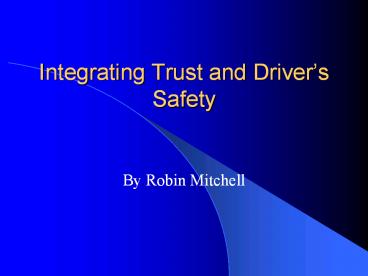Integrating Trust and Driver - PowerPoint PPT Presentation
Title:
Integrating Trust and Driver
Description:
Integrating Trust and Driver s Safety By Robin Mitchell – PowerPoint PPT presentation
Number of Views:110
Avg rating:3.0/5.0
Title: Integrating Trust and Driver
1
Integrating Trust and Drivers Safety
- By Robin Mitchell
2
Components of Focus Area
- Improving driving safety through the use of in
vehicle warning devices - Trust in automation
3
Automotive Warning Devices
- Designed to help alert the driver to potentially
dangerous driving situations - Currently, there are several
- Adaptive Cruise Control (ACC)
- Forward Collision Warning (FCW)
4
Adaptive Cruise Control (ACC)
- Uses radar and laser range sensors to detect
vehicles ahead of the driver and adjusts the
vehicles speed to maintain a minimum headway
with the other vehicles - Able to control the engine, power train, and/or
the service breaks
5
Adaptive Cruise Control (ACC)
- Maintains both set speed and headway
- Is able to control both these settings for the
vehicle and adapt them to the current driving
situation
6
Forward Collision Warning (FCW)
- Uses the same sensors as ACC to assess collision
potential and warn the driver of emerging
collision situations - Helps the driver to avoid striking the rear end
of another vehicle
7
Combined Use of ACC and FCW
- Improve ability to avoid collisions by helping
the driver to maintain safe speeds and headways - Conveyed through visual, auditory, and tactile
cues - Helps refocus driver attention when it is
diverted to another place
8
Example of ACC and FCW
- If ACC detects a slower or stopped vehicle, it
will create an alert - If the driver does nothing, this would cause the
FCW to also alert (as a forward collision would
be imminent) - It is up to the driver to react to the warnings
9
Change in Driving Tasks
- Changes driver tasks by taking some control from
the driver - Creates different tasks for the driver to perform
- The driver relies on the automation to determine
the safety of the situation
10
Trust Defined
- Generally it is an attitude towards technology
regarding expected performance - Most widely used definition comes from Mayer,
Davis, and Schoorman, 1995 - the willingness of a party to be vulnerable to
the actions of another party based on the
expectation that the other will perform a
particular action important to the trustor,
irrespective of the ability to monitor or control
that party
11
Characteristics that govern Trust
- Ability the group of skills, competencies, and
characteristics that enable the agent to
influence the domain. - Similar to predictability
- Integrity degree to which the agent follows a
set of principles - Similar to dependability
- Benevolence the extent to which the motivations
of the agent are aligned with those of the
trustor - Working towards a common goal
12
Trust is dependant on 3 dimensions
- Performance
- Process
- Purpose of Automation
- Definitions from Trust in Technology
Designing for Appropriate - Reliance by John Lee and Katrina
See
13
Performance
- The competency or perceived expertise of the
automation as demonstrated by its ability to
achieve the operators goals - In other words, will it do what I want it to do
- Trust will increase when the automation performs
to expectations
14
Process
- The degree to which the algorithms of the
automation adhere to the operators understanding
of how the automation works - In other words, does it work like I think it
should work in this situation - Trust will increase if the algorithms used are
appropriate for the current situation
15
Purpose of Automation
- The degree to which the automation is being used
within the realm of the designers intent - In other words, is it being used in the manner
for which it was designed - This is often based on if the designers intent
has been properly communicated to the operator - Trust will increase when the automation performs
as intended
16
Trust based on Use
- Trust is largely based on observation
- If a system is not trusted, it will not be
usedtrust will not grow - The more the automation is used, the more trust
will be facilitated in the system - Highly trusted automation is monitored less
frequently
17
Trusting ACC and FCW
- ACC and FCW are emerging technologies with the
possibility of improving driving safety - Drivers need to trust these automations and use
them appropriately - An important concept not yet investigated
18
Proposed Research
- Investigate the degree of trust a driver places
in these devices - Test ACC and FCW individually
- Test ACC and FCW together
- Examine the differences in driver trust across
conditions
19
Integrating Trust and Drivers Safety
- Questions?































